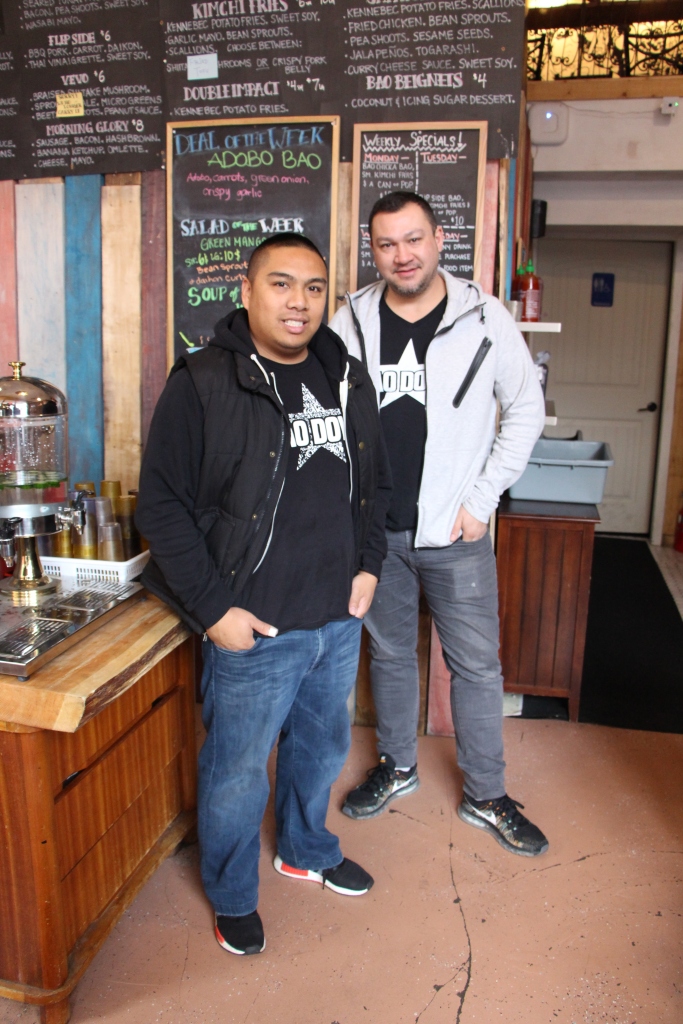
Ranked in the top 15 of Conde Nast Traveler’s 2015 “Best Food Cities in the World,” and host to many award-winning restaurants, the city is dominating the industry. This can be attributed to the abundance of local chefs who continue to push the boundaries between food and culture.
Filipino-inspired restaurant Bao Down in Gastown, owned and managed by brothers-in-law Matthew Adolfo and Greg Edwards, offers affordable fusion, and attracts all demographics. In their first year, they opened two other locations in Vancouver, and have already begun expansion internationally.
The demand has grown for Bao Down’s original version of Taiwanese “gua bao,” or steamed buns, filled with Asian ingredients with a contemporary twist.

Bao Down is successful at “keeping it fresh,” not only with locally-sourced ingredients but with the venue itself, which showcases local art and blasts 90s hip hop music. Adolfo said the atmosphere reflects his youth growing up in a Filipino household in Toronto.
“We thought – why can’t we go to a restaurant with our style of cooking?” he said. “It’s always been Cactus Clubs or Earls […] Why can’t there be an Asian style of this?”
“What we’re doing makes people feel comfortable enough to go into a real traditional place and still have the knowledge behind it.” – Chef Greg Edwards, Bao Down
Chef Edwards believes the city needed to be introduced to gua bao in a non-traditional form. When creating new bao recipes, he finds inspiration from his upbringing in East Vancouver, the Philippines and his schooling in the U.S.
“We want to make it Asian, but then I like to fuse things and make them better,” he said. “Not necessarily make them different, but accentuate the flavours that we’re trying to focus on, which is the Asian aspect.”
Why fusion now? Edwards believes it’s a balance of having both a large Asian population in the city and people who are willing to explore other cultures.
“What we’re doing makes people feel comfortable enough to go into a real traditional place and still have the knowledge behind it,” he said. “It’s growth for people to have more of a food culture and understanding of food and where it comes from.”
Vancouver has been known as a Mecca for pan-Asian influences and flavours for years. This multicultural food trend is now quickly becoming one of the city’s staple cuisines.
The variety available in Vancouver is what Maggi Mei, a popular Vancouver food blogger, believes makes the city an international food hub.
“[It’s] the blending of healthy and wholesome with decadent and monstrous,” she said. “And in our city it all comes together.”
Mei, who blogs part time as a hobby, primarily reviews new and popular restaurants in the city. She has met fusion food in many forms, and said it reflects the culture of Vancouver.
“Food parallels the people who consume it,” she said. “We are as diverse as the food we cook and that which our restaurants serve.”
The acceptance and veneration of fusion food is caused by a number of factors, but Vancouver’s legacy for being an integrative, multicultural community cannot be ignored.
According to a 2011 Statistics Canada report, mixed race unions make up 9.6 per cent of couples in Metro Vancouver — the largest percentage per capita than any other city in the country. This makes a huge difference in terms of cultural fusion and understanding. Along with Toronto, Vancouver also has the highest portion of visible minorities. An abundance of diverse ethnic restaurants was a natural response to this cultural shift.
“Because Vancouver is so multicultural, it opens our eyes to a much bigger world.” – Samantha Grobler
Samantha Grobler is a graduate of Vancouver Community College’s culinary arts program and has worked as a chef at Craft Beer Market. She grew up eating a combination of her father’s Dutch food and her mother’s Filipino cooking.
“I don’t even have words to describe some of the food I ate as a kid,” Grobler said.
As someone who grew up with different flavours, she reminisces about eating Filipino sinigang when she was sick, and how her dad kept bratwurst in the house at all times. She said fusion is a comfort to her and a reminder of her childhood.
“I think in that sense it’s important to our identity.” she said. In this way, fusion food allows generations of Asian-Canadians and people of mixed-race to keep the roots of their culture while doing something different.

“As soon as you lose the authenticity of what it’s actually supposed to be, is it fusion, or are you just trying to smack two things together to make it work?” she said. “I think too many people these days take fusion a little bit too far, and then you lose too much of one thing instead of making one work into another.”
Despite this, Grobler said her experience cooking as a kid helped her adapt to and experiment with unfamiliar flavours in the kitchen. She isn’t worried about the cultural appropriation of food as fusion, as long as it continues to unify different communities.
“Because Vancouver is so multicultural, it opens our eyes to a much bigger world,” she said. “People that didn’t grow up here are a little more at home because they know that the food they grew up with is more accessible. I think we’re very lucky.”